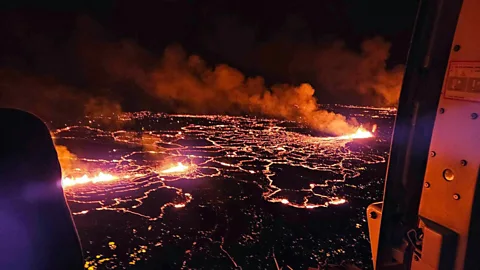Iceland volcano: The seismic sounds as a sudden eruption tore open the Earth

 Getty Images
Getty ImagesThe cacophony of seismic activity that ripped a 4km-long fissure in the Reykjanes peninsula has been turned into audible clips.
Somewhere beneath Iceland's Reykjanes Peninsula, it sounds like a door has been slamming. It's been accompanied by some furious knocking and the occasional crash. These are the sounds reverberating through the Earth's crust as magma has intruded upwards towards the surface.
Seismologists have been closely monitoring this part of southern Iceland since early November when they noticed a dramatic increase in earthquake activity close to the fishing town of Grindavik. In recent weeks, it had quietened down. But then at around 9pm on Monday 18 December, there was a sudden symphony of seismic noise just before the magma broke the surface.
Eyewitnesses in the area reported seeing the sky light up with a red glow and smoke billowing into the air as a long fissure cracked open and lava spurted out. Fortunately, around 4,000 people were evacuated from Grindavik – just 4km (2.5 miles) away – in November, but the eruption could be seen from Iceland's capital Reykjavik, about 42km (26 miles) away.
But another 3,000 miles (4,800km) away, Suzan van der Lee experienced the eruption in a very different way. From her office at Northwestern University in Evanston, Illinois, she could hear a sudden burst of banging – much like a brief downpour of hail on a tin roof before a much louder bang.
Van der Lee, a seismologist at the university, had recently been at an international geology conference in San Francisco where the Reykjanes earthquakes were a hot topic of discussion. She is leading a project to transform seismic signals that reverberate through the Earth into audible sound. The project allows members of the public to listen to the grinding and crunching of our planet through an app called Earthtunes. But it is also giving seismologists a new way of analysing their data.
"It is a powerful way to convey the enormous power of the Earth," says van der Lee. "An earthquake signal that sounds like a door slamming when elevated by 10 octaves is in reality a 'door slamming' inside the Earth's crust, where the door is roughly a thousand times larger than our typical doors."
By example, she says, imagine a sliding door measuring 1km by 2km (0.6 miles x 1.2 miles) suddenly slamming shut.
In early December the activity from beneath Reykjanes appeared to have quietened somewhat following an intense flurry of earthquakes in early November. Audio clips converted from the signals picked up by a seismographic station to the north of Reykjavik revealed sounds similar to the cracking of ice cubes, someone banging insistently on a door and the occasional door slam. Describing it at the time, van der Lee said "the activity is formidable, exciting and scary".
Then by mid-November the seismic activity quietened, suggesting the magma intrusion near Grindavik had ceased moving as much – although the nearby Svartsengi volcano continued to experience uplift as magma built up at deeper levels. On 16 December, the Icelandic Meteorological Office, which monitors volcanic activity, reported the rate of deformation of the land around Svartsengi had decreased in recent days, but it was "too early to say if magma accumulation" had stopped.
Then on 18 December, a swarm of earthquakes started at 9pm Icelandic time. A little more than an hour later, a rapidly growing fissure tore open across the landscape to the northeast of Grindavik, allowing lava to pour out at the rate of hundreds of cubic metres per second. At the north end of the fissure, fountains of lava burst upwards and a slick of glowing molten rock spread out on either side of the crack.
By 3pm on 19 December, the fissure had grown to around 4km (2.5 miles) in length, running from a south-westerly direction towards the edge of Grindavik town.
Van der Lee says it is possible to hear the sudden growth of the fissure in the recordings captured by the seismographic equipment. "It gets quieter later on as the fissure is more or less fully formed and allowing the magma to freely flow to the surface, without fracturing any more crust," she says.
But listening to these audible clips of seismic activity can provide valuable insights for scientists studying eruptions such as these.
"Typically seismologists visualise ground motion data in graphs called seismograms," says van der Lee. "Translating sections of the data to the audible spectrum provides a unique and complementary way to get first impressions of the overall data. It helps with data exploration and discovery of new types of signals or signal sequences.
"With Earthtunes, one can often hear earthquakes that are not immediately visible in data. Of course, the Icelandic Meteorological Office applies filters and other transformations to the data to find and visualise these signals, so they don't go undetected even when they're not visible in the raw data."
Although this eruption is not likely to bring the kind of widespread disruption to air travel that the Eyjafjallajökull volcano did in 2010, it has led to the closure of tourist attractions such as the Blue Lagoon. Officials in Iceland have warned that the seismic activity caused by the eruption could last for months.
If so, it means van der Lee and her colleagues could glean a lot more information from those strange noises from deep beneath our feet.
--
If you liked this story, sign up for The Essential List newsletter – a handpicked selection of features, videos and can't-miss news delivered to your inbox every Friday.
